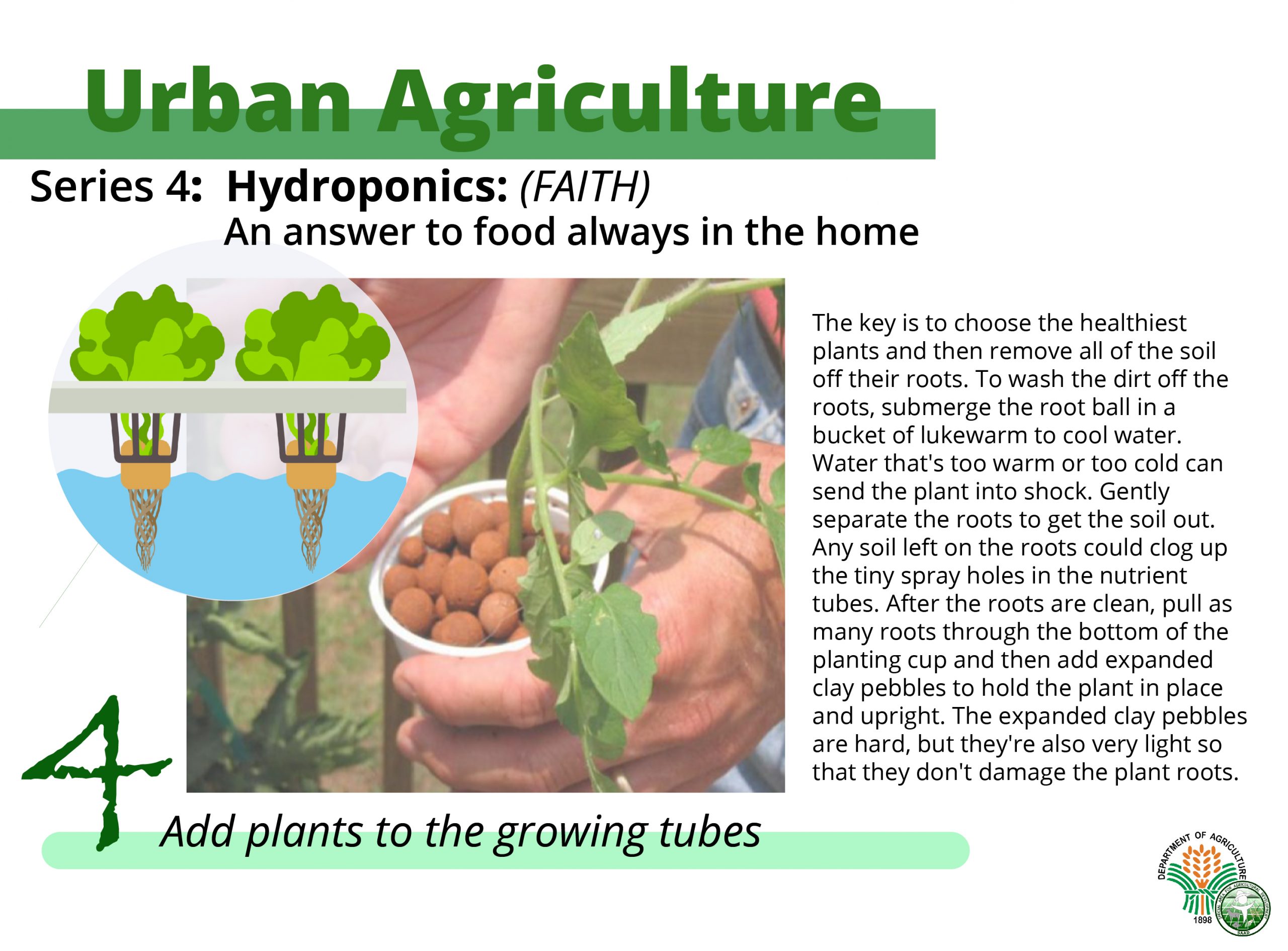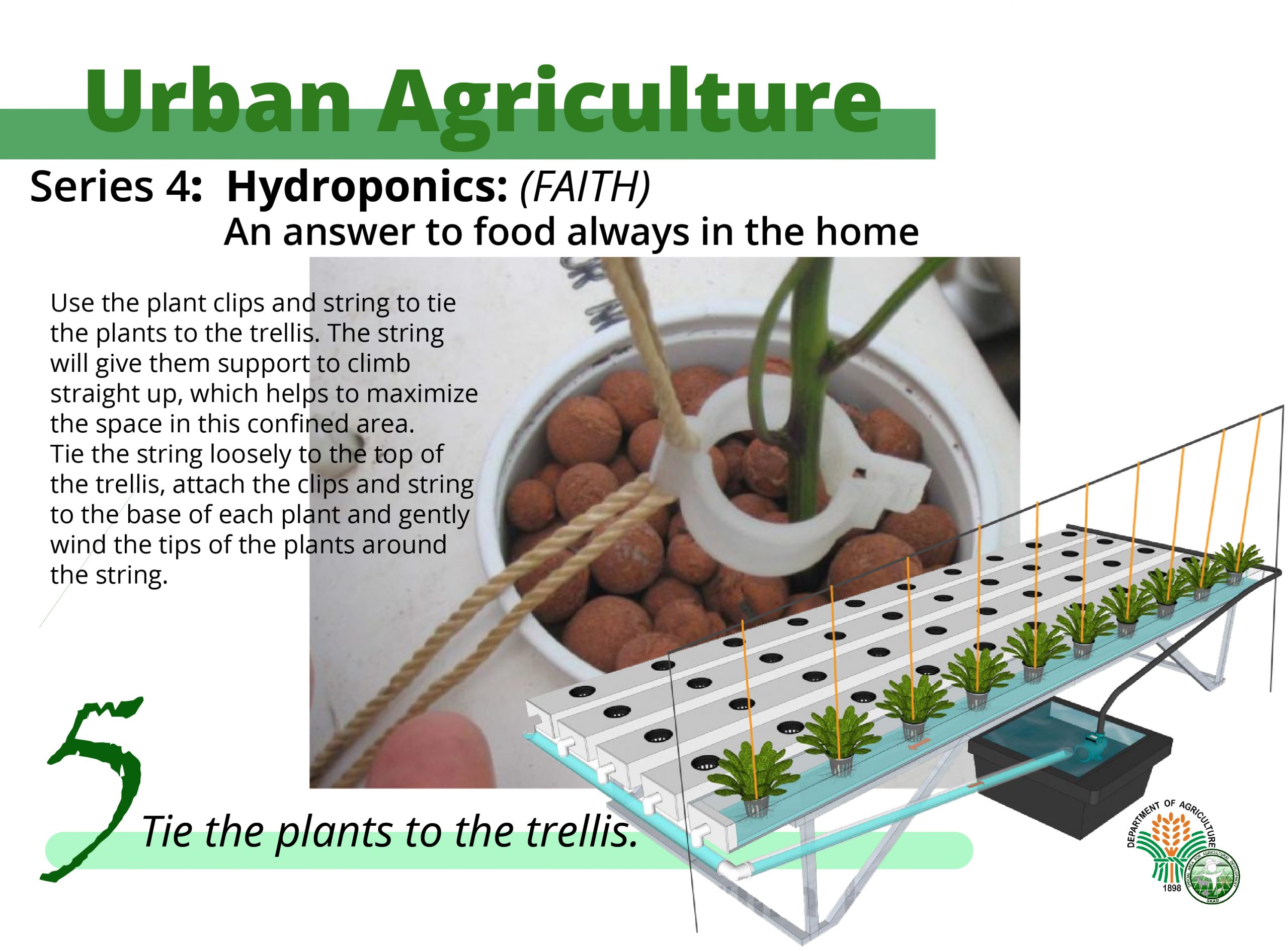PART 4: Hydroponics: an answer to food always in the home (FAITH)
Placing the puzzle of Hydroponics among the big players of this agenda is surprisingly not very difficult because it fits so well to major headlines, e.g. climate change and energy conservation, mega cities and urbanization, an increase of the world’s population, food security, health and welfare, water scarcity, agricultural resources and so on. This article will provide an overview only, not claiming to be that entire comprehensive.
We all know that people continue to flock to cities due to economic, social and creative opportunities they acquire. However, urbanization also presents major challenges. In the Philippines, urbanization is rapidly increasing with almost 49% of Filipinos now living in urban areas, and by 2030, that number is expected to jump to 77%. Much of this urbanization has occurred in its largest cities like Baguio, Cebu, Davao, and Metro Manila. Metro Manila, for instance, has more than 12 million inhabitants, many living in dense communities with large building structures. Traffic congestion, rising fuel prices, and poor road infrastructure have produced a problem in transporting agricultural products from rural areas to urban markets where more people reside and where the food is consumed more. The same scenario that we can see in urban areas of the poorest of the poor provinces covered by the Special Area for Agricultural Development (SAAD) Program.
Urban and peri-urban agriculture is one of the key solutions to global food insecurity, however, due to land scarcity inside urban areas, implementation of this solution is challenging. To address this, urban and peri-urban hydroponic farming is introduced since hydroponics is an effective way of conserving both water and space.
Urban and peri-urban agriculture has seen in recent years a clear shift mainly to produce vegetables for food and ornamentals for beautification. As a matter of proof, the identified risks have diminished by the implementation of hydroponics such in the case of Taiwan and England. This technology has met the demands of modern cities for physical and psychological in- and out-door relaxation; for improving the city environment; and for food and income security to provide year-round a wide variety of fresh fruits and vegetables. Moreover, hydroponics reduces water needs and cultivation space for plant growth, minimizes food health risks of harvested produce, and helps to check environmental contamination.
Hydroponics is not an invention of our time. The Hanging Gardens of Babylon and the Floating Gardens of the Aztecs were beautifying the civic centers; in addition, fruit trees and vegetables were cultivated in such places. It is part of the ecological system to manage the urban environment. In an arid climate, it can increase humidity and lower temperatures. It captures dust and polluted air by the foliage of the plants. It can contribute to the reduction of the net discharge of CO2, one of the gases speculated to contribute to global warming, because plants and trees need CO2 for photosynthesis. The captive action, of course, is at its highest during the vegetation growth phase. In cities, however, much of the carbon stored in vegetation is likely to be quickly released through decomposition to organic matter, so lasting effect is little.
All this shows that hydroponics has a positive impact upon the greening and cleaning of the cities, offering green zones for micro-climate changes (shade, temperature, sequestration of CO2). Most importantly, city dwellers will enjoy such green areas, enhancing community self-esteem, and stimulating community livelihood.
Taiwan has the largest Asia’s vertical farming, the Yes Health iFarm, which uses a hydroponics system, has a technology-driven 14-story vertical farm covering 2,645 square meters, and grows over 30 varieties of vegetables, including arugula, ice plant, and mustard leaf. At least 80% of Taipei’s department stores are supplied by the iFarm.
Another is an underground advanced indoor vertical farm in Liverpool, North England called Farm Urban, which is the creation of Jens Thomas and Paul Myers in 2014. Bok choi, parsley, tarragon, and basil alongside dozens of varieties of lettuce grow together in harmony under the pink glow of a LED light set-up. Their aim is to change people’s relationship with food: the traditional methods of agriculture, they say, and using acres of land is no longer sustainable. The world’s population is growing – the World Health Organization estimates it will increase to 9.7 billion people by 2050, with 70% of people living in urban areas. “To preserve natural habitats and improve worldwide food security there should be a complete overhaul of food production methods”, said Thomas and Myers.
Hydroponics: A Precision Agriculture
Hydroponic systems are presently being experimented on and diligently employed in the available lands, building spaces, or rooftops within the confines of the urban and peri-urban areas of the country. Hydroponics is a climate-smart agriculture technology and an art of growing plants without soil using mineral nutrient solutions in water. With hydroponics, plants are grown in an inert medium, and a balanced pH adjusted nutrient solution delivered to the roots in a highly soluble form. This allows plants to uptake their food with very little effort. There are several types of hydroponics systems — some of which are the wick system, the deep-water culture system, the ebb and flow (or flood and drain) system, drip systems, the nutrient film technique (NFT) system, the aeroponic system, and the simple nutrient addition program (SNAP) system.
NFT is one of the most popular types of hydroponics systems. It is versatile and modular due to the nature of its components. It works by delivering nutrient solution to the plants by means of using a water pump. Gravity then guides the water back to the main reservoir. A key element of a good N.F.T. is how the nutrient solution flows over the roots. The word “film” is ideally a small amount of water flowing through the channels to allow plants to get a sufficient amount of oxygen. The most commonly used plants in this setup are lettuce, basil, and salad greens (i.e. watercress).
Based on precision agriculture, hydroponics crop growing systems can increase yields by at least 30%, and can harvest in a short period of time (i.e. 30 days for leafy vegetables such as lettuce, watercress, kangkong, pechay, bok choi, etc.) while converting inputs like seeds, nutrients, and time invested into bigger and healthier profits. The systems optimize irrigation, using only the quantity of water that crops need. Several studies suggest that hydroponics gardening empowers households to have direct access to clean food and is a source of family income; encourages recycling; answers government’s efforts to implement smart farming agriculture; and realizes conservation of limited resources, such as water, electricity, space, and time.
Building the Hydroponics Garden
There are various ways of growing things hydroponically. In one popular method, people stand their plants in a plastic trough and let a nutrient solution trickle past their roots (with the help of gravity and a pump). That’s called the nutrient-film technique: the nutrient is like a kind of liquid conveyor belt — it’s constantly sliding past the roots delivering to them the goodness they need. Alternatively, people can grow plants with their roots supported by a nutrient-enriched medium such as rock wool, sand, or vermiculite, which acts as a sterile substitute for soil.
Another method is called aeroponics and it’s typified by a popular product called the AeroGarden. Although the name suggests growing plants in air, the roots are actually suspended inside a container full of extremely humid air. Effectively, the roots grow in a nutrient-rich aerosol a bit like a cloud packed full of minerals.
Various crops, such as tomatoes, zucchini, cucumbers, bell peppers, lettuce, celery, watercress, strawberries, honeydew melons, Mediterranean and Asian herbs, and Asian greens are among plants that do particularly well in hydroponics.
Here are the DIY Network’s steps in building a hydroponics garden using the nutrient-film technique:
In our next Urban Agriculture Series, we’ll teach you the aquaponics at home. ###
Writers:
Myer Mula, SAAD Program Director
Jemiema Arro, SAAD Public Relations and Communications Officer
References:
- Bartok J. 2009. Overview of Hydroponic Production. University of Massachusetts Amherst. Retrieved from https://ag.umass.edu/greenhouse-floriculture/fact-sheets/hydroponic-systems in June 2020.
- Basingan D and Ilagan K. 2012. Urbanization by the numbers. Philippine Center for Investigative Journalism. Retrieved from: http://pcij.org/stories/ urbanization-by-the-numbers/
- Carandang VI JSR, Taylor RW and Calleja JS. 2016. Urban Rooftop Hydroponics for Diversified Agriculture. Pathways Out of Poverty. Pages 361-374.
- Deelstra T and Girardet H. 2005. Urban agriculture and sustainable cities. RUAF Foundation Growing Cities
- DIY Network. (n.d.). How to Assemble a Homemade Hydroponic System. Scripps Networks, LLC. Retrieved from https://www.diynetwork.com/how-to/outdoors/gardening/how-to-assemble-a-homemade-hydroponic-system in June 2020.
- Dyna-Gro, Inc. 2018. Hydroponics: Advantages and Disadvantages. Retrieved from Dyna-Gro: https://dyna-gro.com/hydroponics-advantages-and- disadvantages/April.
- FAO. 2010. Growing Greener Cities. http://www.fao.org/ag/agp/greenercities/
- Kozai T, Niu G and Takagaki M. 2015. Plant Factory (1st Ed.). An indoor vertical farming system for efficient equality food production, ISBN: 978017753, Elsevier
- Langenhoven P. 2016. Opportunities in Hydroponics. Purdue University. Retrieved from https://ag.purdue.edu/hla/fruitveg/Presentations/Langenhoven_Hydroponics_IVGS2016b.pdf on June 2020.
- Parveen N. 2019. ‘This is the farming of the future’: the rise of hydroponic food labs. The Guardian. Retrieved from https://www.theguardian.com/environment/2019/dec/26/farming-of-the-future-rise-of-hydroponic-food-labs-thomas-myers in June 2020
- Rodriguez TA. 2015. CLSU unit helps agri-entrepreneurs wanting to go into hydroponics. Retrieved from. https://www.agriculture.com.ph/2018/05/09/this-clsu-unit-helps-agrientrepreneurs-wanting-to-go-into-hydroponics/
- Sace CF. 2015. Hydroponics: Honing Tomorrow’s Agriculture. Central Luzon State University Science City of Muñoz, Nueva Ecija
- Schnitzler WH. 2012. Urban Hydroponics for Green and Clean Cities and for Food Security. ISHS Acta Horticulturae 1004: International Symposium on Soilless Cultivation.
- Schumacher HJ. 2017. One of the top urban innovation: Urban Farming. https://businessmirror.com.ph.
- Tagle S, Benioza H, Perna R and Oblea A. 2018. Development of an Indoor Hydroponic Tower for Urban Farming. Presented at the 6th DLSU Innovation and Technology Fair 2018, De La Salle University, Manila, Philippines. 22-23 November.
























Comments (0)